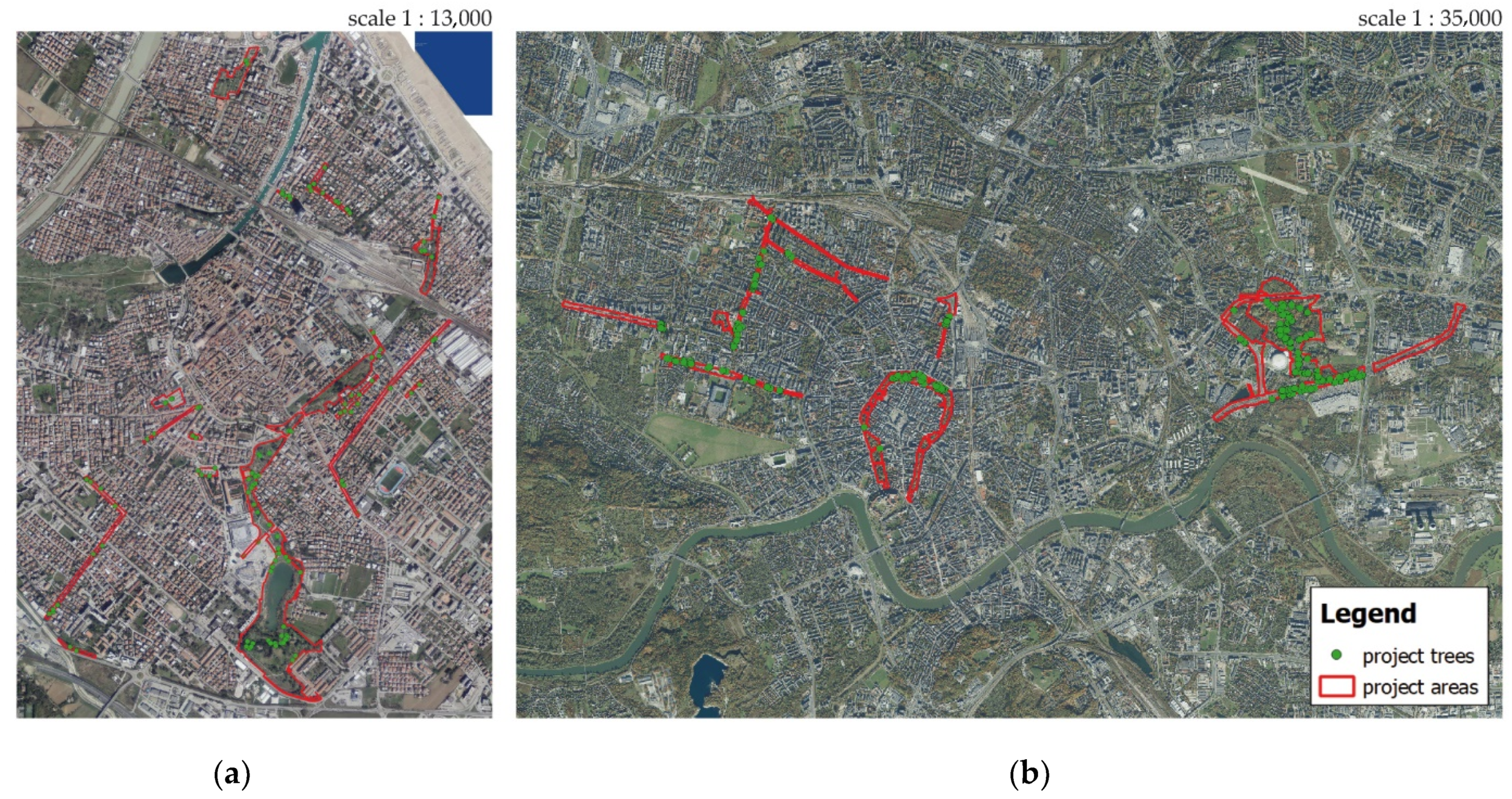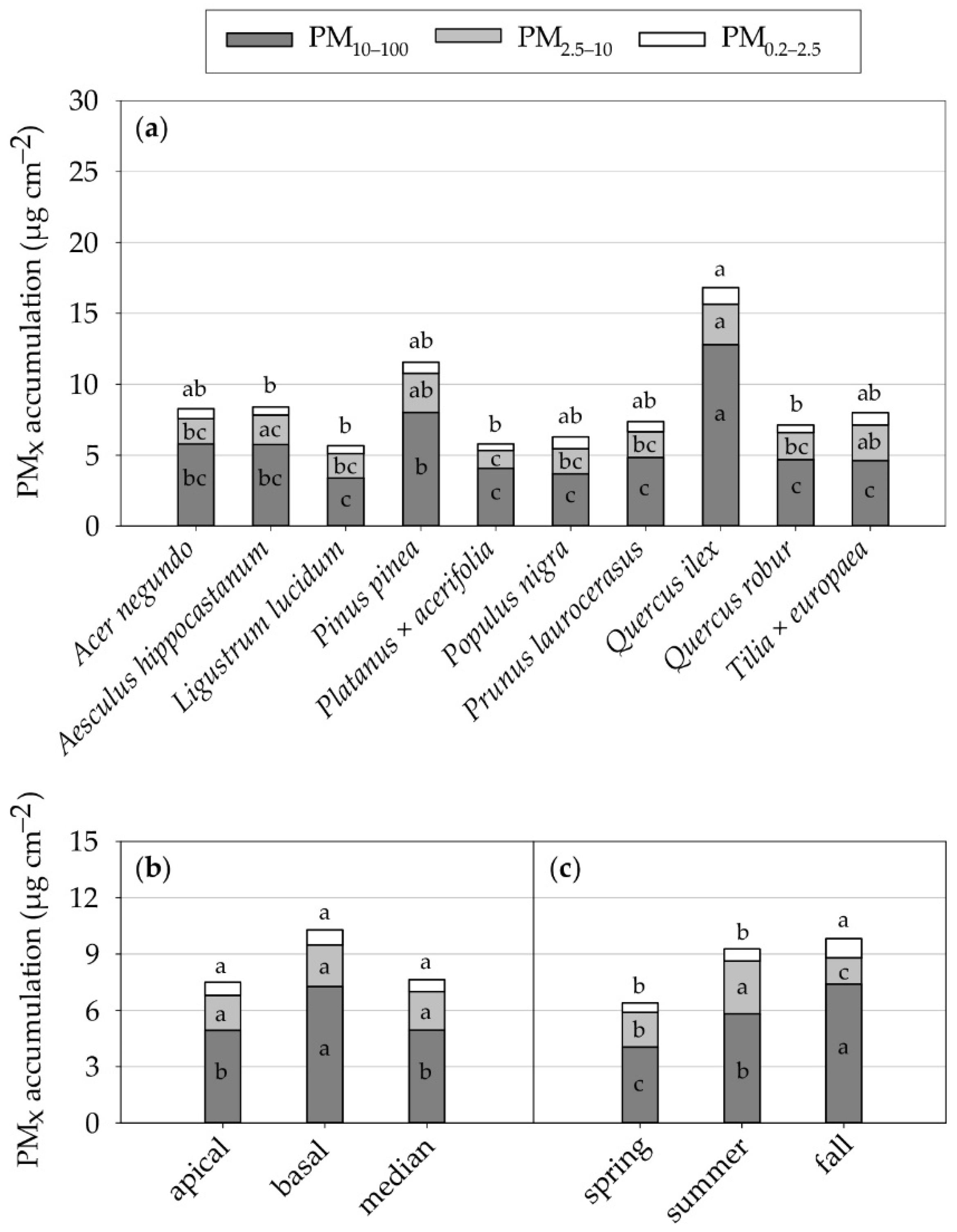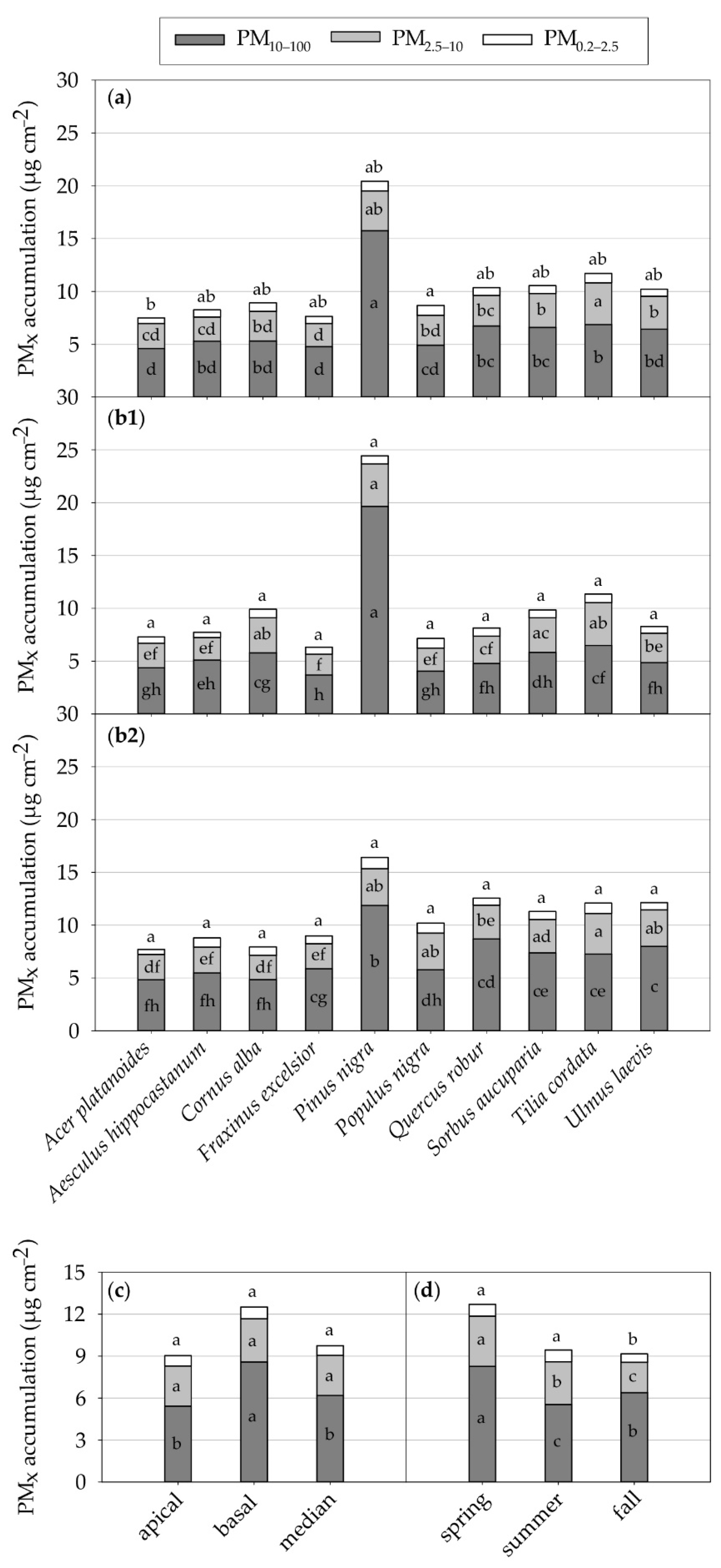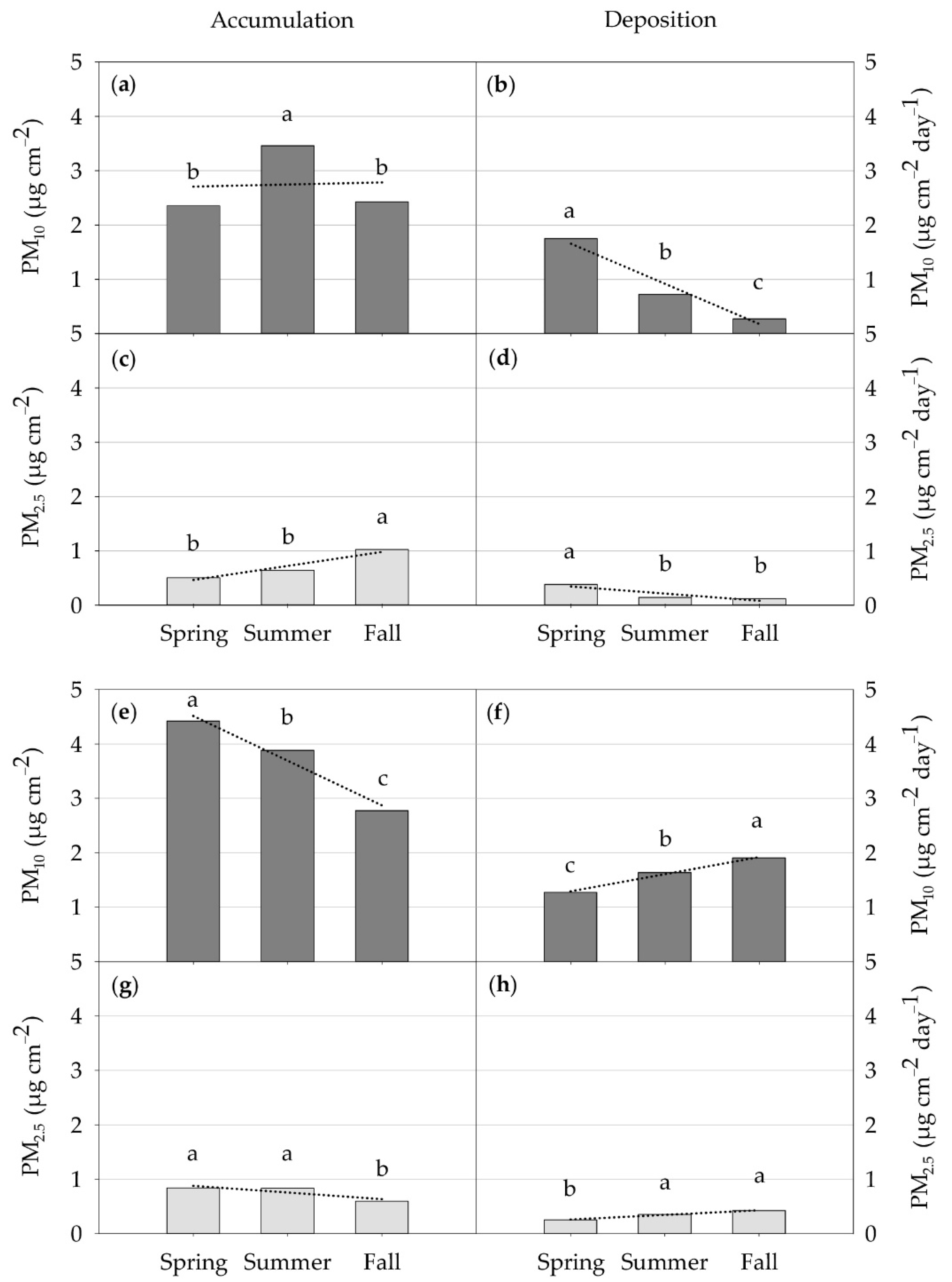Particulate Pollution Capture by Seventeen Woody Species Growing in Parks or along Roads in Two European Cities
Abstract
:1. Introduction
2. Materials and Methods
2.1. Experimental Sites
2.2. Plant Material and Experimental Design
2.3. Sampling
2.4. Determination of PMx Accumulation
2.5. Determination of PMx Deposition
2.6. Statistical Analysis
3. Results
3.1. Meteorological Conditions and Air Quality at Experimental Sites
3.2. PMx Accumulation in Rimini
3.3. PMx Accumulation in Krakow
3.4. PMx Deposition in Rimini and Krakow
3.5. Comparison among Accumulation and Deposition Trends throughout the Year
3.6. Correlation among PMx Leaf Capture and Meteorological and Environmental Parameters
4. Discussion
4.1. Effect of Species and Strata on PMx Accumulation and Deposition
4.2. Effect of Leaf Position on PMx Accumulation
4.3. Effect of the Season on PMx Accumulation and Deposition
4.4. Effect of the Meteorological and Environmental Parameters on PMx Accumulation
5. Conclusions
Author Contributions
Funding
Acknowledgments
Conflicts of Interest
Appendix A
| City | Factor | Accumulation | Deposition | |||
|---|---|---|---|---|---|---|
| PM10–100 | PM2.5–10 | PM0.2–2.5 | PM10 | PM2.5 | ||
| Rimini | Species | ** | ** | ** | ** | ** |
| Strata | n.s. | n.s. | n.s. | n.s. | n.s. | |
| Position | ** | n.s. | n.s. | n.s. | n.s. | |
| Season | ** | ** | ** | ** | ** | |
| Species × Strata | n.s. | n.s. | n.s. | ** | n.s. | |
| Krakow | Species | ** | ** | * | ** | ** |
| Strata | * | n.s. | n.s. | ** | n.s. | |
| Position | ** | n.s. | n.s. | n.s. | n.s. | |
| Season | ** | ** | ** | ** | ** | |
| Species × Strata | ** | ** | n.s. | ** | ** | |
References
- Bell, M.L.; Morgenstern, R.D.; Harrington, W. Quantifying the Human Health Benefits of Air Pollution Policies: Review of Recent Studies and New Directions in Accountability Research. Environ. Sci. Policy 2011, 14, 357–368. [Google Scholar] [CrossRef]
- Łukowski, A.; Popek, R.; Karolewski, P. Particulate Matter on Foliage of Betula Pendula, Quercus Robur, and Tilia Cordata: Deposition and Ecophysiology. Environ. Sci. Pollut. Res. 2020, 27, 10296–10307. [Google Scholar] [CrossRef] [Green Version]
- AQEG (Air Quality Expert Group). Particulate Matter in the UK: Summary; Department for the Environment, Food and Rural Affairs: London, UK, 2005; ISBN 0-85521-144-X.
- Dzierzanowski, K.; Popek, R.; Gawrońska, H.; Saebø, A.; Gawroński, S.W. Deposition of Particulate Matter of Different Size Fractions on Leaf Surfaces and in Waxes of Urban Forest Species. Int. J. Phytoremediat. 2011, 13, 1037–1046. [Google Scholar] [CrossRef]
- Sæbø, A.; Popek, R.; Nawrot, B.; Hanslin, H.M.; Gawronska, H.; Gawronski, S.W. Plant Species Differences in Particulate Matter Accumulation on Leaf Surfaces. Sci. Total Environ. 2012, 427–428, 347–354. [Google Scholar] [CrossRef]
- Popek, R.; Gawrońska, H.; Wrochna, M.; Gawroński, S.W.; Sæbø, A. Particulate Matter on Foliage of 13 Woody Species: Deposition on Surfaces and Phytostabilisation in Waxes—A 3-Year Study. Int. J. Phytoremediat. 2013, 15, 245–256. [Google Scholar] [CrossRef] [PubMed]
- Pomata, D.; Di Filippo, P.; Riccardi, C.; Castellani, F.; Simonetti, G.; Sonego, E.; Buiarelli, F. Toxic Organic Contaminants in Airborne Particles: Levels, Potential Sources and Risk Assessment. Int. J. Environ. Res. Public Health 2021, 18, 4352. [Google Scholar] [CrossRef]
- EEA (European Environment Agency). Air Quality in Europe—2015 Report. Off. Off. Publ. Eur. Communities Cph. 2015, 5, 57. [Google Scholar] [CrossRef]
- Nemmar, A.; Hoet, P.H.M.; Vanquickenborne, B.; Dinsdale, D.; Thomeer, M.; Hoylaerts, M.F.; Vanbilloen, H.; Mortelmans, L.; Nemery, B. Passage of Inhaled Particles into the Blood Circulation in Humans. Circulation 2002, 106, 411–414. [Google Scholar] [CrossRef] [PubMed] [Green Version]
- USEPA. Air Quality Criteria for Particulate Matter October 2004, Volume 2. Air Qual. Criteria Part. Matter 2004, II, 1148. [Google Scholar]
- EEA (European Environment Agency). Air Quality in Europe—2019 Report. Publ. Off. Eur. Union Luxemb. 2019, 10, 99. [Google Scholar] [CrossRef]
- Conticini, E.; Frediani, B.; Caro, D. Can Atmospheric Pollution Be Considered a Co-Factor in Extremely High Level of SARS-CoV-2 Lethality in Northern Italy? Environ. Pollut. 2020, 261, 114465. [Google Scholar] [CrossRef]
- Hewitt, C.N.; Ashworth, K.; MacKenzie, A.R. Using Green Infrastructure to Improve Urban Air Quality (GI4AQ). Ambio 2020, 49, 62–73. [Google Scholar] [CrossRef] [PubMed] [Green Version]
- Beckett, K.P.; Freer-Smith, P.H.; Taylor, G. Urban Woodlands: Their Role in Reducing the Effects of Particulate Pollution. Environ. Pollut. 1998, 99, 347–360. [Google Scholar] [CrossRef]
- Mori, J.; Hanslin, H.M.; Burchi, G.; Sæbø, A. Particulate Matter and Element Accumulation on Coniferous Trees at Different Distances from a Highway. Urban For. Urban Green. 2015, 14, 170–177. [Google Scholar] [CrossRef]
- Sanusi, R.; Johnstone, D.; May, P.; Livesley, S.J. Microclimate Benefits That Different Street Tree Species Provide to Sidewalk Pedestrians Relate to Differences in Plant Area Index. Landsc. Urban Plan. 2017, 157, 502–511. [Google Scholar] [CrossRef]
- Speak, A.; Montagnani, L.; Wellstein, C.; Zerbe, S. The Influence of Tree Traits on Urban Ground Surface Shade Cooling. Landsc. Urban Plan. 2020, 197, 103748. [Google Scholar] [CrossRef]
- Tan, P.Y.; Wong, N.H.; Tan, C.L.; Jusuf, S.K.; Schmiele, K.; Chiam, Z.Q. Transpiration and Cooling Potential of Tropical Urban Trees from Different Native Habitats. Sci. Total Environ. 2020, 705, 135764. [Google Scholar] [CrossRef] [PubMed]
- Fini, A.; Frangi, P.; Mori, J.; Donzelli, D.; Ferrini, F. Nature Based Solutions to Mitigate Soil Sealing in Urban Areas: Results from a 4-Year Study Comparing Permeable, Porous, and Impermeable Pavements. Environ. Res. 2017, 156, 443–454. [Google Scholar] [CrossRef]
- Weissert, L.F.; Salmond, J.A.; Schwendenmann, L. Photosynthetic CO2 uptake and carbon sequestration potential of deciduous and evergreen tree species in an urban environment. Urban Ecosyst. 2017, 20, 663–674. [Google Scholar] [CrossRef]
- Sicard, P.; Agathokleous, E.; Araminiene, V.; Carrari, E.; Hoshika, Y.; De Marco, A.; Paoletti, E. Should We See Urban Trees as Effective Solutions to Reduce Increasing Ozone Levels in Cities? Environ. Pollut. 2018, 243, 163–176. [Google Scholar] [CrossRef]
- Xu, X.; Yu, X.; Mo, L.; Xu, Y.; Bao, L.; Lun, X. Atmospheric Particulate Matter Accumulation on Trees: A Comparison of Boles, Branches and Leaves. J. Clean. Prod. 2019, 226, 349–356. [Google Scholar] [CrossRef]
- Nowak, D.J.; Crane, D.E.; Stevens, J.C. Air Pollution Removal by Urban Trees and Shrubs in the United States. Urban For. Urban Green. 2006, 4, 115–123. [Google Scholar] [CrossRef]
- Bealey, W.J.; McDonald, A.G.; Nemitz, E.; Donovan, R.; Dragosits, U.; Duffy, T.R.; Fowler, D. Estimating the Reduction of Urban PM10 Concentrations by Trees within an Environmental Information System for Planners. J. Environ. Manag. 2007, 85, 44–58. [Google Scholar] [CrossRef]
- Mitchell, R.; Maher, B.A.; Kinnersley, R. Rates of Particulate Pollution Deposition onto Leaf Surfaces: Temporal and Inter-Species Magnetic Analyses. Environ. Pollut. 2010, 158, 1472–1478. [Google Scholar] [CrossRef]
- Petroff, A.; Mailliat, A.; Amielh, M.; Anselmet, F. Aerosol Dry Deposition on Vegetative Canopies. Part I: Review of Present Knowledge. Atmos. Environ. 2008, 42, 3625–3653. [Google Scholar] [CrossRef]
- Ferrini, F.; Fini, A.; Mori, J.; Gori, A. Role of Vegetation as a Mitigating Factor in the Urban Context. Sustainability 2020, 12, 4247. [Google Scholar] [CrossRef]
- Nowak, D.J.; Hirabayashi, S.; Bodine, A.; Hoehn, R. Modeled PM2.5 Removal by Trees in Ten U.S. Cities and Associated Health Effects. Environ. Pollut. 2013, 178, 395–402. [Google Scholar] [CrossRef] [PubMed]
- Litschike, T.; Kuttler, W. On the Reduction of Urban Particle Concentration by Vegetation—A Review. Meteorol. Z. 2008, 17, 229–240. [Google Scholar] [CrossRef]
- Weerakkody, U.; Dover, J.W.; Mitchell, P.; Reiling, K. Quantification of the Traffic-Generated Particulate Matter Capture by Plant Species in a Living Wall and Evaluation of the Important Leaf Characteristics. Sci. Total Environ. 2018, 635, 1012–1024. [Google Scholar] [CrossRef] [PubMed]
- Baraldi, R.; Chieco, C.; Neri, L.; Facini, O.; Rapparini, F.; Morrone, L.; Rotondi, A.; Carriero, G. An Integrated Study on Air Mitigation Potential of Urban Vegetation: From a Multi-Trait Approach to Modeling. Urban For. Urban Green. 2019, 41, 127–138. [Google Scholar] [CrossRef]
- Li, X.; Zhang, T.; Sun, F.; Song, X.; Zhang, Y.; Huang, F.; Yuan, C.; Yu, H.; Zhang, G.; Qi, F.; et al. The relationship between particulate matter retention capacity and leaf surface micromorphology of ten tree species in Hangzhou, China. Sci. Total Environ. 2021, 771, 144812. [Google Scholar] [CrossRef]
- Mori, J.; Fini, A.; Burchi, G.; Ferrini, F. Carbon Uptake and Air Pollution Mitigation of Different Evergreen Shrub Species. Arboric. Urban For. 2016, 42, 329–345. [Google Scholar] [CrossRef]
- Chen, L.; Liu, C.; Zhang, L.; Zou, R.; Zhang, Z. Variation in Tree Species Ability to Capture and Retain Airborne Fine Particulate Matter (PM2.5). Sci. Rep. 2017, 7, 3206. [Google Scholar] [CrossRef]
- Zhang, L.; Zhang, Z.; Chen, L.; McNulty, S. An Investigation on the Leaf Accumulation-Removal Efficiency of Atmospheric Particulate Matter for Five Urban Plant Species under Different Rainfall Regimes. Atmos. Environ. 2019, 208, 123–132. [Google Scholar] [CrossRef]
- Beckett, K.P.; Freer-Smith, P.H.; Taylor, G. Particulate Pollution Capture by Urban Trees: Effect of Species and Windspeed. Glob. Chang. Biol. 2000, 6, 995–1003. [Google Scholar] [CrossRef]
- Abhijith, K.V.; Kumar, P. Quantifying Particulate Matter Reduction and Their Deposition on the Leaves of Green Infrastructure. Environ. Pollut. 2020, 265, 114884. [Google Scholar] [CrossRef]
- Wang, H.; Shi, H.; Li, Y.; Yu, Y.; Zhang, J. Seasonal Variations in Leaf Capturing of Particulate Matter, Surface Wettability and Micromorphology in Urban Tree Species. Front. Environ. Sci. Eng. 2013, 7, 579–588. [Google Scholar] [CrossRef]
- Przybysz, A.; Sæbø, A.; Hanslin, H.M.; Gawroński, S.W. Accumulation of Particulate Matter and Trace Elements on Vegetation as Affected by Pollution Level, Rainfall and the Passage of Time. Sci. Total Environ. 2014, 481, 360–369. [Google Scholar] [CrossRef]
- Fowler, D.; Cape, J.N.; Unsworth, M.H. Deposition of Atmospheric Pollutants on Forests. Philos. Trans. -R. Soc. Lond. B 1989, 324, 247–265. [Google Scholar] [CrossRef]
- Gromke, C.; Ruck, B. Influence of Trees on the Dispersion of Pollutants in an Urban Street Canyon-Experimental Investigation of the Flow and Concentration Field. Atmos. Environ. 2007, 41, 3287–3302. [Google Scholar] [CrossRef] [Green Version]
- Abhijith, K.V.; Kumar, P.; Gallagher, J.; McNabola, A.; Baldauf, R.; Pilla, F.; Broderick, B.; Di Sabatino, S.; Pulvirenti, B. Air Pollution Abatement Performances of Green Infrastructure in Open Road and Built-up Street Canyon Environments—A Review. Atmos. Environ. 2017, 162, 71–86. [Google Scholar] [CrossRef]
- Pugh, T.A.M.; MacKenzie, A.R.; Whyatt, J.D.; Hewitt, C.N. Effectiveness of Green Infrastructure for Improvement of Air Quality in Urban Street Canyons. Environ. Sci. Technol. 2012, 46, 7692–7699. [Google Scholar] [CrossRef] [PubMed] [Green Version]
- Ottelé, M.; van Bohemen, H.D.; Fraaij, A.L.A. Quantifying the Deposition of Particulate Matter on Climber Vegetation on Living Walls. Ecol. Eng. 2010, 36, 154–162. [Google Scholar] [CrossRef]
- Mori, J.; Fini, A.; Galimberti, M.; Ginepro, M.; Burchi, G.; Massa, D.; Ferrini, F. Air Pollution Deposition on a Roadside Vegetation Barrier in a Mediterranean Environment: Combined Effect of Evergreen Shrub Species and Planting Density. Sci. Total Environ. 2018, 643, 725–737. [Google Scholar] [CrossRef] [PubMed]
- Baidourela, A.; Halik, Ü.; Aishan, T.; Abliz, A.; Elyas, A. Dust Retention Effects of Populus Alba Var. Pyramidalis (Bunge) in Arid Oasis Cities Northwest China. Fresenius Environ. Bull. 2015, 24, 285–290. [Google Scholar]
- Gómez-Moreno, F.J.; Artíñano, B.; Ramiro, E.D.; Barreiro, M.; Núñez, L.; Coz, E.; Dimitroulopoulou, C.; Vardoulakis, S.; Yagüe, C.; Maqueda, G.; et al. Urban Vegetation and Particle Air Pollution: Experimental Campaigns in a Traffic Hotspot. Environ. Pollut. 2019, 247, 195–205. [Google Scholar] [CrossRef]
- Tiwari, A.; Kumar, P.; Baldauf, R.; Zhang, K.M.; Pilla, F.; Di Sabatino, S.; Brattich, E.; Pulvirenti, B. Considerations for Evaluating Green Infrastructure Impacts in Microscale and Macroscale Air Pollution Dispersion Models. Sci. Total Environ. 2019, 672, 410–426. [Google Scholar] [CrossRef] [Green Version]
- Xing, Y.; Brimblecombe, P.; Wang, S.; Zhang, H. Tree Distribution, Morphology and Modelled Air Pollution in Urban Parks of Hong Kong. J. Environ. Manag. 2019, 248, 109304. [Google Scholar] [CrossRef]
- ARPAE. Aggiornamento Dell’inventario Regionale Delle Emissioni in Atmosfera Dell’emilia-Romagna Relativo All’anno 2017 (INEMAR-ER 2017). Rapporto Finale Settembre. 2020. Available online: https://www.arpae.it/it/temi-ambientali/aria/inventario-emissioni/inventario_emissioni_2017.pdf (accessed on 30 August 2021).
- Główny Inspektorat Ochrony Środowiska. Departament Monitoringu Środowiska. Regionalny Wydział Monitoringu Środowiska w Krakowie. Stan Środowiska w Województwie Małopolskim Raport. 2020. Available online: https://www.gios.gov.pl/images/dokumenty/pms/raporty/stan_srodowiska_2020_malopolskie.pdf (accessed on 30 August 2021).
- Han, Q.; Kawasaki, T.; Nakano, T.; Chiba, Y. Leaf-Age Effects on Seasonal Variability in Photosynthetic Parameters and Its Relationships with Leaf Mass per Area and Leaf Nitrogen Concentration within a Pinus Densiflora Crown. Tree Physiol. 2008, 28, 551–558. [Google Scholar] [CrossRef] [Green Version]
- Chen, L.; Liu, C.; Zou, R.; Yang, M.; Zhang, Z. Experimental Examination of Effectiveness of Vegetation as Bio-Filter of Particulate Matters in the Urban Environment. Environ. Pollut. 2016, 208, 198–208. [Google Scholar] [CrossRef]
- Xu, X.; Zhang, Z.; Bao, L.; Mo, L.; Yu, X.; Fan, D.; Lun, X. Influence of Rainfall Duration and Intensity on Particulate Matter Removal from Plant Leaves. Sci. Total Environ. 2017, 609, 11–16. [Google Scholar] [CrossRef] [PubMed]
- Xu, X.; Xia, J.; Gao, Y.; Zheng, W. Additional Focus on Particulate Matter Wash-off Events from Leaves Is Required: A Review of Studies of Urban Plants Used to Reduce Airborne Particulate Matter Pollution. Urban For. Urban Green. 2020, 48, 126559. [Google Scholar] [CrossRef]
- Grote, R.; Samson, R.; Alonso, R.; Amorim, J.H.; Cariñanos, P.; Churkina, G.; Fares, S.; Le Thiec, D.; Niinemets, Ü.; Mikkelsen, T.N.; et al. Functional Traits of Urban Trees: Air Pollution Mitigation Potential. Front. Ecol. Environ. 2016, 14, 543–550. [Google Scholar] [CrossRef]
- Esposito, F.; Memoli, V.; Panico, S.C.; Di Natale, G.; Trifuoggi, M.; Giarra, A.; Maisto, G. Leaf Traits of Quercus Ilex L. Affect Particulate Matter Accumulation. Urban For. Urban Green. 2020, 54, 126780. [Google Scholar] [CrossRef]
- Qiu, Y.; Guan, D.; Song, W.; Huang, K. Capture of Heavy Metals and Sulfur by Foliar Dust in Urban Huizhou, Guangdong Province, China. Chemosphere 2009, 75, 447–452. [Google Scholar] [CrossRef]
- Leonard, R.J.; McArthur, C.; Hochuli, D.F. Particulate Matter Deposition on Roadside Plants and the Importance of Leaf Trait Combinations. Urban For. Urban Green. 2016, 20, 249–253. [Google Scholar] [CrossRef]
- Beckett, K.P.; Freer-Smith, P.; Taylor, G. Effective Tree Species for Local Air-Quality Management. J. Arboric. 2000, 26, 13–19. [Google Scholar]
- Freer-Smith, P.H.; Beckett, K.P.; Taylor, G. Deposition Velocities to Sorbus Aria, Acer Campestre, Populus Deltoides × Trichocarpa “Beaupré”, Pinus Nigra and × Cupressocyparis Leylandii for Coarse, Fine and Ultra-Fine Particles in the Urban Environment. Environ. Pollut. 2005, 133, 157–167. [Google Scholar] [CrossRef]
- Sgrigna, G.; Baldacchini, C.; Dreveck, S.; Cheng, Z.; Calfapietra, C. Relationships between Air Particulate Matter Capture Efficiency and Leaf Traits in Twelve Tree Species from an Italian Urban-Industrial Environment. Sci. Total Environ. 2020, 718, 137310. [Google Scholar] [CrossRef]
- Freer-Smith, P.H.; Holloway, S.; Goodman, A. The Uptake of Particulates by an Urban Woodland: Site Description and Particulate Composition. Environ. Pollut. 1997, 95, 27–35. [Google Scholar] [CrossRef]
- Mori, J.; Sæbø, A.; Hanslin, H.M.; Teani, A.; Ferrini, F.; Fini, A.; Burchi, G. Deposition of Traffic-Related Air Pollutants on Leaves of Six Evergreen Shrub Species during a Mediterranean Summer Season. Urban For. Urban Green. 2015, 14, 264–273. [Google Scholar] [CrossRef]
- Tallis, M.; Taylor, G.; Sinnett, D.; Freer-Smith, P. Estimating the Removal of Atmospheric Particulate Pollution by the Urban Tree Canopy of London, under Current and Future Environments. Landsc. Urban Plan. 2011, 103, 129–138. [Google Scholar] [CrossRef]
- Rötzer, T.; Moser-Reischl, A.; Rahman, M.A.; Grote, R.; Pauleit, S.; Pretzsch, H. Modelling Urban Tree Growth and Ecosystem Services: Review and Perspectives. Prog. Bot. 2020, 82, 405–464. [Google Scholar] [CrossRef]
- Sgrigna, G.; Sæbø, A.; Gawronski, S.; Popek, R.; Calfapietra, C. Particulate Matter Deposition on Quercus Ilex Leaves in an Industrial City of Central Italy. Environ. Pollut. 2015, 197, 187–194. [Google Scholar] [CrossRef] [PubMed]
- Hofman, J.; Stokkaer, I.; Snauwaert, L.; Samson, R. Spatial Distribution Assessment of Particulate Matter in an Urban Street Canyon Using Biomagnetic Leaf Monitoring of Tree Crown Deposited Particles. Environ. Pollut. 2013, 183, 123–132. [Google Scholar] [CrossRef] [PubMed]
- Popek, R.; Haynes, A.; Przybysz, A.; Robinson, S.A. How Much Does weather Matter? Effects of Rain and Wind on PM Accumulation by Four Species of Australian Native Trees. Atmosphere 2019, 10, 633. [Google Scholar] [CrossRef] [Green Version]
- Janhäll, S. Review on Urban Vegetation and Particle Air Pollution—Deposition and Dispersion. Atmos. Environ. 2015, 105, 130–137. [Google Scholar] [CrossRef]
- Xie, C.; Kan, L.; Guo, J.; Jin, S.; Li, Z.; Chen, D.; Li, X.; Che, S. A Dynamic Processes Study of PM Retention by Trees under Different Wind Conditions. Environ. Pollut. 2018, 233, 315–322. [Google Scholar] [CrossRef]
- Wang, H.; Shi, H.; Wang, Y. Effects of Weather, Time, and Pollution Level on the Amount of Particulate Matter Deposited on Leaves of Ligustrum Lucidum. Sci. World J. 2015, 2015, 9–11. [Google Scholar] [CrossRef] [Green Version]




| City | Species | DBH Min. (cm) | DBH Max. (cm) |
|---|---|---|---|
| Rimini | Acer negundo | 9.80 | 44.56 |
| Aesculus hippocastanum | 5.50 | 49.34 | |
| Ligustrum lucidum | 8.00 | 30.24 | |
| Pinus pinea | 21.65 | 60.16 | |
| Platanus × acerifolia | 7.60 | 63.66 | |
| Populus nigra | 7.50 | 76.08 | |
| Prunus laurocerasus | 4.00 | 37.88 | |
| Quercus ilex | 11.50 | 59.52 | |
| Quercus robur | 8.30 | 48.38 | |
| Tilia × europaea | 7.00 | 58.89 | |
| Krakow | Acer platanoides | 5.00 | 83.40 |
| Aesculus hippocastanum | 33.00 | 109.18 | |
| Cornus alba | 2.23 | 7.00 | |
| Fraxinus excelsior | 4.50 | 81.49 | |
| Pinus nigra | 4.46 | 32.15 | |
| Populus nigra | 18.00 | 90.40 | |
| Quercus robur | 31.00 | 87.54 | |
| Sorbus aucuparia | 5.00 | 29.60 | |
| Tilia cordata | 7.00 | 73.21 | |
| Ulmus laevis | 4.00 | 96.45 |
| City | Period | Season | T (°C) | Rain (mm) | Wind (m·s−1) | RH (%) | PM10 (µg·m−3) | PM2.5 (µg·m−3) |
|---|---|---|---|---|---|---|---|---|
| Rimini | 30 April–24 May 2019 | Spring | 14.59 | 103.74 | 3.11 | 74.31 | 15.60 | 4.61 |
| 11 June–5 July 2019 | Summer | 25.34 | 27.82 | 2.43 | 65.31 | 26.02 | 10.13 | |
| 26 September–19 October 2018 | Fall | 15.93 | 25.39 | 2.32 | 80.58 | 33.87 | 21.10 | |
| Krakow | 21 May–13 June 2019 | Spring | 18.63 | 199.98 | 2.58 | 73.15 | 32.40 | 18.22 |
| 2–26 July 2019 | Summer | 18.35 | 133.21 | 2.65 | 65.33 | 26.40 | 14.98 | |
| 27 August–20 September 2019 | Fall | 16.63 | 202.01 | 2.46 | 77.50 | 29.72 | 17.45 |
| City | Species | PM10 Deposition (µg·cm−2·day−1) | PM2.5 Deposition (µg·cm−2·day−1) | ||
|---|---|---|---|---|---|
| Rimini | Acer negundo | 0.879 | c | 0.236 | b |
| Aesculus hippocastanum | 0.673 | c | 0.150 | b | |
| Ligustrum lucidum | 0.706 | c | 0.146 | b | |
| Pinus pinea | 1.477 | ab | 0.335 | ab | |
| Platanus × acerifolia | 0.529 | c | 0.126 | b | |
| Populus nigra | 0.688 | c | 0.205 | b | |
| Prunus laurocerasus | 0.749 | c | 0.195 | b | |
| Quercus ilex | 1.932 | a | 0.435 | a | |
| Quercus robur | 0.976 | bc | 0.182 | b | |
| Tilia × europaea | 0.759 | c | 0.182 | b | |
| Krakow | Acer platanoides | 1.369 | bd | 0.248 | d |
| Aesculus hippocastanum | 1.548 | ad | 0.374 | ad | |
| Cornus alba | 1.777 | ac | 0.405 | ab | |
| Fraxinus excelsior | 1.098 | d | 0.252 | cd | |
| Pinus nigra | 1.978 | ab | 0.450 | a | |
| Populus nigra | 1.628 | ac | 0.398 | ac | |
| Quercus robur | 1.620 | ac | 0.378 | ab | |
| Sorbus aucuparia | 1.321 | cd | 0.276 | cd | |
| Tilia cordata | 2.062 | a | 0.380 | ad | |
| Ulmus laevis | 1.642 | ac | 0.294 | bd | |
| City | Factor | PM10–100 | PM2.5–10 | PM0.2–2.5 | Wind Speed | Rainfall | Air PM10 | Air PM2.5 |
|---|---|---|---|---|---|---|---|---|
| Rimini | PM10–100 | 0.374 ** | 0.259 ** | −0.202 ** | −0.207 ** | 0.222 ** | 0.219 ** | |
| PM2.5–10 | 0.177 ** | −0.092 ** | ||||||
| PM0.2–2.5 | −0.148 ** | −0.162 ** | 0.162 ** | 0.179 ** | ||||
| Wind speed | 0.978 ** | −0.873 ** | −0.814 ** | |||||
| Rainfall | −0.891 ** | −0.837 ** | ||||||
| Air PM10 | 0.978 ** | |||||||
| Air PM2.5 | ||||||||
| Krakow | PM10–100 | 0.492 ** | 0.194 ** | −0.262 ** | 0.176 ** | |||
| PM2.5–10 | 0.411 ** | 0.248 ** | −0.325 ** | 0.094 * | ||||
| PM0.2–2.5 | 0.206 ** | −0.098 ** | ||||||
| Wind speed | −0.579 ** | −0.503 ** | −0.608 ** | |||||
| Rainfall | 0.195 ** | 0.478 ** | ||||||
| Air PM10 | 0.930 ** | |||||||
| Air PM2.5 |
Publisher’s Note: MDPI stays neutral with regard to jurisdictional claims in published maps and institutional affiliations. |
© 2022 by the authors. Licensee MDPI, Basel, Switzerland. This article is an open access article distributed under the terms and conditions of the Creative Commons Attribution (CC BY) license (https://creativecommons.org/licenses/by/4.0/).
Share and Cite
Vigevani, I.; Corsini, D.; Mori, J.; Pasquinelli, A.; Gibin, M.; Comin, S.; Szwałko, P.; Cagnolati, E.; Ferrini, F.; Fini, A. Particulate Pollution Capture by Seventeen Woody Species Growing in Parks or along Roads in Two European Cities. Sustainability 2022, 14, 1113. https://doi.org/10.3390/su14031113
Vigevani I, Corsini D, Mori J, Pasquinelli A, Gibin M, Comin S, Szwałko P, Cagnolati E, Ferrini F, Fini A. Particulate Pollution Capture by Seventeen Woody Species Growing in Parks or along Roads in Two European Cities. Sustainability. 2022; 14(3):1113. https://doi.org/10.3390/su14031113
Chicago/Turabian StyleVigevani, Irene, Denise Corsini, Jacopo Mori, Alice Pasquinelli, Marco Gibin, Sebastien Comin, Przemysław Szwałko, Edoardo Cagnolati, Francesco Ferrini, and Alessio Fini. 2022. "Particulate Pollution Capture by Seventeen Woody Species Growing in Parks or along Roads in Two European Cities" Sustainability 14, no. 3: 1113. https://doi.org/10.3390/su14031113
APA StyleVigevani, I., Corsini, D., Mori, J., Pasquinelli, A., Gibin, M., Comin, S., Szwałko, P., Cagnolati, E., Ferrini, F., & Fini, A. (2022). Particulate Pollution Capture by Seventeen Woody Species Growing in Parks or along Roads in Two European Cities. Sustainability, 14(3), 1113. https://doi.org/10.3390/su14031113








